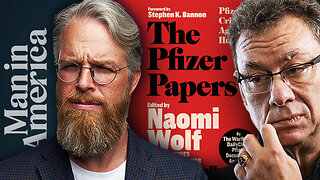Premium Only Content

Episode 2327: St. King Henry II
Early Life and Background
St. Henry II, also known as Henry the Saint, was born on May 6, 973, in Albach, Bavaria, to Henry the Quarrelsome, Duke of Bavaria, and Gisela of Burgundy. From his early years, Henry was immersed in the Catholic faith, instilled by his devout parents. His education was deeply influenced by the Church, particularly under the tutelage of St. Wolfgang of Regensburg, who would leave an indelible mark on young Henry’s spiritual and intellectual formation.
Rise to Power
Henry’s ascent to power began after the death of Emperor Otto III in 1002. Henry, then Duke of Bavaria, was elected King of Germany. His reign was characterized by his unwavering commitment to the Church and his efforts to maintain the unity and strength of the Holy Roman Empire. Henry saw his role as divinely appointed, viewing his kingship as a sacred duty to uphold Christian values and defend the Church.
Marriage to St. Cunigunde (COO-Nea-Gond)
In 999, Henry married Cunigunde of Luxembourg, a woman of profound piety and virtue. Their marriage was a model of Christian holiness. Despite political pressures, Henry and Cunigunde chose to live in chastity, dedicating their lives to God and the welfare of their subjects. Cunigunde would later be canonized as a saint herself, recognized for her sanctity and contributions to the Church.
Emperorship and Ecclesiastical Reforms
In 1014, Henry was crowned Holy Roman Emperor by Pope Benedict VIII. His reign as emperor was marked by significant ecclesiastical reforms and a deep commitment to the Cluniac movement, which sought to reform monastic life and ensure the purity and independence of the Church. Henry worked tirelessly to eliminate simony and enforce clerical celibacy, striving to restore the moral integrity of the clergy.
Defender of the Faith
Henry’s military campaigns were driven by his desire to protect Christendom. He defended the Empire’s borders against pagan and heretical threats, always seeking to expand the influence of the Church. His victories were seen not just as political triumphs but as manifestations of God’s will. Henry’s deep faith guided his policies and actions, making him a true soldier of Christ.
Patron of Churches and Monasteries
Throughout his reign, Henry was a generous patron of churches, monasteries, and charitable institutions. He founded the Diocese of Bamberg in 1007, which became a center of learning and piety. His support for monastic communities helped to spread the spiritual renewal initiated by the Cluniac reforms. Henry’s contributions to the Church’s infrastructure were immense, leaving a lasting legacy of faith and devotion.
Personal Piety and Legacy
Henry was known for his personal piety, humility, and ascetic lifestyle. Despite his imperial status, he lived simply and devotedly. His life was marked by a profound sense of duty to God and his people. After a reign filled with both spiritual and temporal achievements, Henry died on July 13, 1024.
Controversial Aspects of St. Henry II’s Life
Political Maneuvering and Ambitions:
Henry’s rise to power was marked by significant political maneuvering. After the death of Emperor Otto III in 1002, Henry was quick to assert his claim to the throne. His election as King of Germany was contested, and he faced opposition from other nobles who had their own claims or preferred other candidates. Henry's path to the throne involved negotiations, alliances, and, at times, coercion. This political pragmatism, though common in medieval politics, occasionally clashed with his image as a saintly ruler.
Conflict with Bolesław I of Poland:
One of the most contentious aspects of Henry’s reign was his conflict with Bolesław I of Poland. The relationship between the Holy Roman Empire and Poland was strained, and Henry engaged in several military campaigns against Bolesław. These conflicts were partly driven by Henry’s desire to maintain imperial authority over the Polish territories and to expand his influence. The war culminated in the Peace of Bautzen in 1018, which saw a temporary resolution but left lingering tensions. Critics argue that Henry's military actions, while politically motivated, were at odds with his role as a promoter of peace and Christian values.
Issues with Italian Nobility:
Henry’s efforts to assert control over Italy also led to conflicts. His attempts to impose imperial authority were met with resistance from the Italian nobility, who valued their autonomy. In 1022, Henry led a campaign to enforce his rule, which included the capture and punishment of rebellious nobles. While these actions were aimed at consolidating his power and ensuring the stability of the empire, they were controversial and seen by some as heavy-handed.
Relationship with the Papacy:
Although generally supportive of the Church, Henry’s relationship with the papacy had its complexities. His involvement in the election of popes and the influence he wielded over ecclesiastical appointments were seen by some as overreach. While Henry sought to ensure that the Church remained free of corruption and simony, his actions sometimes blurred the lines between secular and ecclesiastical authority, leading to tensions with some church leaders.
Accusations of Harshness:
Some contemporaries and later historians have criticized Henry for his harshness in dealing with opposition. His efforts to maintain order and enforce his policies occasionally involved severe measures against those who resisted his rule. While intended to preserve the stability and integrity of the empire, these actions sometimes painted Henry as a stern and unforgiving ruler.
St. King Henry II of England is infamously associated with the murder of Thomas Becket, the Archbishop of Canterbury. The conflict between Henry II and Becket arose from disputes over the rights and privileges of the Church. Their relationship deteriorated, leading to Becket's murder on December 29, 1170.
The specifics are as follows:
Conflict with the Church: Henry II sought to reduce the power of the Church and increase royal authority. This led to a series of clashes with Becket, whom Henry had initially appointed as Archbishop, expecting him to be an ally.
The Murder: In a fit of frustration, Henry is reported to have exclaimed something along the lines of, "Will no one rid me of this turbulent priest?" This statement was interpreted by four of his knights as a royal command. They traveled to Canterbury and murdered Becket in Canterbury Cathedral.
Aftermath: The murder caused an enormous scandal. Henry II faced immense pressure from both the Church and the public. He performed public penance in 1174, including a scourging by monks at Becket's tomb, to atone for his perceived role in the murder.
While Henry II did not explicitly order Becket's murder, his angry words and ongoing conflict with Becket were seen as the catalyst for the knights' actions. This tragic event ultimately reinforced the power and martyrdom of Thomas Becket, who was canonized as a saint by Pope Alexander III in 1173.
The 1964 Hollywood film "Becket," starring Richard Burton as Thomas Becket and Peter O'Toole as King Henry II, takes several liberties with historical facts for dramatic purposes. Here are some of the key inaccuracies and artistic embellishments in the movie
Relationship between Henry and Becket:
Film Version: The film portrays Henry and Becket as close personal friends, with a deep bond of loyalty and affection.
Historical Reality: While they had a professional relationship, there is limited historical evidence to suggest that they were personal friends as depicted. Becket served Henry loyally as Chancellor, but their relationship was more complex and professional than portrayed.
Becket's Background:
Film Version: The film depicts Becket as a Saxon commoner, emphasizing the class conflict between the Norman King Henry and the Saxon Becket.
Historical Reality: Thomas Becket was actually of Norman descent, like Henry, and his family was reasonably well-off. The depiction of Becket as a Saxon commoner is a fictional device to heighten the dramatic tension.
Becket’s Transformation:
Film Version: The movie suggests a sudden and almost miraculous transformation in Becket’s character and piety upon becoming Archbishop of Canterbury.
Historical Reality: Becket did undergo a significant transformation, but it was more gradual and rooted in genuine religious conviction. His shift from Henry’s loyal Chancellor to a defender of the Church’s rights was a complex process influenced by various factors.
Henry’s Motivation:
Film Version: The film implies that Henry appointed Becket as Archbishop to control the Church through his friend.
Historical Reality: While Henry may have hoped that Becket would be a compliant Archbishop, the motivations and political context were more nuanced. Henry sought to reduce clerical privileges and assert royal authority over the Church, and Becket's appointment was part of this broader strategy.
The Murder of Becket:
Film Version: The film dramatizes the murder, showing the knights acting directly on Henry’s explicit orders.
Historical Reality: Henry II did not directly order Becket’s murder. His exclamation, interpreted by the knights as a command, was more ambiguous. The knights acted on their interpretation of Henry’s frustrated outburst rather than a direct royal command.
Characterization of Henry and Becket:
Film Version: The characters are dramatized for cinematic effect, with Henry portrayed as a tormented and impulsive ruler, and Becket as a noble and principled martyr.
Historical Reality: Both men were complex figures with multifaceted motivations and actions. Henry was a shrewd and capable ruler, and Becket’s actions were driven by a combination of personal conviction and political considerations.
While "Becket" captures the essence of the conflict between Church and State and the dramatic tension between the two main characters, it sacrifices historical accuracy for narrative and emotional impact.
Struggles with Internal Dissent:
Henry faced internal dissent from within his own ranks, particularly from regional dukes and nobles who were wary of his centralizing policies. His efforts to strengthen imperial authority often clashed with the desires of local rulers to maintain their traditional rights and privileges. These internal conflicts sometimes led to open rebellion, requiring Henry to balance diplomacy with military action.
Canonization and Feast Day
Henry was canonized by Pope Eugene III in 1146, becoming one of the few monarchs to be recognized as a saint by the Catholic Church. His feast day is celebrated on July 15, the anniversary of his death. St. Henry II is remembered as a model of Christian kingship, a defender of the Church, and a man of deep faith and virtue.
Conclusion
St. Henry II’s life exemplifies the virtues of a Catholic ruler dedicated to the service of God and His Church. His legacy continues to inspire the faithful, reminding us of the importance of integrating faith into all aspects of life, including governance and public service. Through his intercession, may we strive to live lives of holiness and devotion, always seeking to uphold the teachings and values of our Catholic faith.
-
 1:06:01
1:06:01
Man in America
1 day agoPfizer Has Been Caught RED HANDED w/ Dr. Chris Flowers
32K10 -
 2:24:15
2:24:15
Slightly Offensive
7 hours ago $10.31 earnedAttempted ASSASSINATION of Nick J Fuentes LEAVES 1 DEAD! | Guest: Mel K & Breanna Morello
27.5K16 -
 1:43:08
1:43:08
Roseanne Barr
7 hours ago $18.15 earned"Ain't Nobody Good" with Jesse Lee Peterson | The Roseanne Barr Podcast #79
66K30 -

The StoneZONE with Roger Stone
4 hours agoTrump Should Sue Billionaire Governor JB Pritzker for Calling Him a Rapist | The StoneZONE
39.7K4 -
 1:36:58
1:36:58
Flyover Conservatives
23 hours agoAmerica’s Psychiatrist Speaks Out: Are We Greenlighting Violence? - Dr. Carole Lieberman | FOC Show
24.4K5 -
 3:51:34
3:51:34
Akademiks
6 hours agoJay Z War against Diddy Accuser Lawyer GOES CRAZY! Lil Baby Speaks OUT! Cardi v Offset? Bhad Bhabie?
79.7K6 -
 1:15:42
1:15:42
Josh Pate's College Football Show
7 hours ago $0.82 earnedCFP Changes Coming | Transfer Portal Intel | Games Of The Year | Head Coaches Set To Elevate
24.4K -
 1:21:17
1:21:17
Donald Trump Jr.
9 hours agoWhat are These Mystery Drones? Plus Inside the Swamp’s CR. Interview with Lue Elizondo | TRIGGERED Ep.200
120K119 -
 37:54
37:54
Kimberly Guilfoyle
9 hours agoAmerica is Healing, Plus Fani Willis Disqualified, Live with Shemane Nugent & Mike Davis | Ep. 182
85.9K45 -
 7:38
7:38
Game On!
7 hours ago $0.68 earnedThe picks you need for Thursday Night Football!
20K1